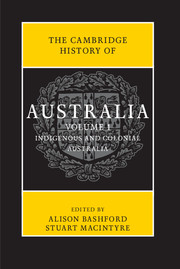Book contents
- Frontmatter
- Contents
- Abbreviations
- List of maps
- List of figures
- List of tables
- Notes on contributors
- Map
- Preface
- Introduction
- PART I
- PART II
- Further reading
- Chronology
- Index
- Frontmatter
- Contents
- Abbreviations
- List of maps
- List of figures
- List of tables
- Notes on contributors
- Map
- Preface
- Introduction
- PART I
- PART II
- 9 Religion
- 10 Culture and media
- 11 Science and medicine
- 12 Society and welfare
- 13 Gender and sexuality
- 14 Indigenous Australia
- 15 Class
- 16 The economy
- 17 Government, law and citizenship
- 18 Education
- 19 The environment
- 20 Travel and connections
- 21 Security
- 22 Australia, Britain and the British Commonwealth
- 23 Australia in the Asia-Pacfic region
- 24 The history anxiety
- Further reading
- Chronology
- Index
19 - The environment
from PART II
Published online by Cambridge University Press: 05 November 2013
- Frontmatter
- Contents
- Abbreviations
- List of maps
- List of figures
- List of tables
- Notes on contributors
- Map
- Preface
- Introduction
- PART I
- PART II
- Further reading
- Chronology
- Index
- Frontmatter
- Contents
- Abbreviations
- List of maps
- List of figures
- List of tables
- Notes on contributors
- Map
- Preface
- Introduction
- PART I
- PART II
- 9 Religion
- 10 Culture and media
- 11 Science and medicine
- 12 Society and welfare
- 13 Gender and sexuality
- 14 Indigenous Australia
- 15 Class
- 16 The economy
- 17 Government, law and citizenship
- 18 Education
- 19 The environment
- 20 Travel and connections
- 21 Security
- 22 Australia, Britain and the British Commonwealth
- 23 Australia in the Asia-Pacfic region
- 24 The history anxiety
- Further reading
- Chronology
- Index
Summary
In November 1902 a giant dust cloud hung over much of the recently established Commonwealth of Australia. Red dust storms blew across the parched land as a result of the Federation Drought that lasted from 1895 to 1903. Plants withered, the ground soil cracked, millions of animals died from thirst and starvation, and the Murray and Darling rivers stopped flowing at points from a lack of water. Meteorologists now know that such droughts were a response to a strong El Niño Southern Oscillation, a climatic system determined by the temperature of the water in the Pacific Ocean. When warm Pacific water drifts east towards Peru and South America in an El Niño phase, Australia receives drought, but when warm water moves westward towards Australia, in a La Niña phase, Australia receives rain. Unbeknown to Australians at the time, weather conditions in the Pacific determined whether farmers received rain for their crops.
Throughout the twentieth century white Australians came to recognise that the continent on which they lived had climates and ecologies that were markedly different from those in Eurasia, the Americas and even nearby New Zealand. In a sense, they had to learn what most of the Aboriginal and Torres Strait Islander people already knew: that much of Australia is prone to drought, flood and fire. Though most Indigenous people learned about these cycles and processes through oral histories, culture and experience, their knowledge was not incorporated into state environmental management models or popular interpretations of nature until the last decades of the twentieth century. Extreme events helped introduce the Australian public to the climatic factors shaping the continent's weather. The best known include the Federation Drought of 1895–1903, the ‘Black Friday’ forest fires in Victoria in 1939, Cyclone Tracy in Darwin and the Brisbane flood in 1974.
In particular, Australians learned throughout the century that drought was a regular and pronounced feature of the continent's climatic cycle.
- Type
- Chapter
- Information
- The Cambridge History of Australia , pp. 452 - 471Publisher: Cambridge University PressPrint publication year: 2013
- 1
- Cited by

